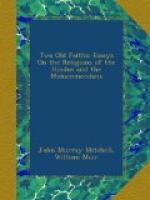[Sidenote: Rammohun Roy. Effect of Christianity upon him.] It is traceable to the efforts of a truly distinguished man, Rammohun Roy. He was a person of studious habits, intelligent, acute, and deeply in earnest on the subject of religion. He studied not only Hinduism in its various forms, but Buddhism, Mohammedanism, and Christianity. He was naturally an eclectic, gathering truth from all quarters where he thought he could find it. A specially deep impression was made on his mind by Christianity; and in 1820 he published a book with the remarkable title, The Precepts of Jesus the Guide to Peace and Happiness. Very frequently he gave expression to the sentiment that the teachings of Christ were the truest and deepest that he knew. Still, he did not believe in Christ’s divinity.
[Sidenote: Debendernath Tagore. Keshub Chunder Sen. Formation of a new Samaj.] In January, 1830, a place of worship was opened by Rammohun Roy and his friends. It was intended for the worship of one God, without idolatrous rites of any kind. This was undoubtedly a very important event, and great was the interest aroused in connection with it. Rammohun Roy, however, visited Britain in 1831, and died at Bristol in 1833; and the cause for which he had so earnestly labored in India languished for a time. But in the year 1841 Debendernath Tagore, a man of character and wealth, joined the Brahmo Somaj, and gave a kind of constitution to it. It was fully organized by 1844. No definite declaration, however, had been made as to the authority of the Vedas; but, after a lengthened period of inquiry and discussion, a majority of the Somaj rejected the doctrine of their infallibility by 1850. “The rock of intuition” now began to be spoken of; man’s reason was his sufficient guide. Still, great respect was cherished for the ancient belief and customs of the land. But in 1858 a new champion appeared on the scene, in the well-known Keshub Chunder Sen. Ardent, impetuous, ambitions—full of ideas derived from Christian sources[34]—he could not brook the slow movements of the Somaj in the path of reform. Important changes, both religious and social, were pressed by him; and the more conservative Debendernath somewhat reluctantly consented to their introduction. Matters were, however, brought to a crisis by the marriage of two persons of different castes in 1864. In February, 1865, the progressive party formally severed their connection with the original Somaj; and in August, 1869, they opened a new place of worship of their own. Since this time the original or Adi Somaj has been little heard of, and its movement—if it has moved at all—has been retrogressive. The new Somaj—the Brahmo Somaj of India, as it called itself—under the guidance of Mr. Sen became very active. A missionary institute was set up, and preachers were sent over a great part of India. Much was accomplished on behalf of women; and in 1872 a Marriage Act for members of the Somaj was passed by the Indian legislature, which legalized union between people of different castes, and fixed on fourteen as the lowest age for the marriage of females. These were important reforms.




